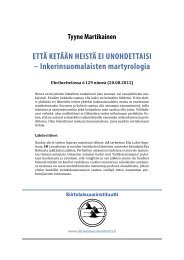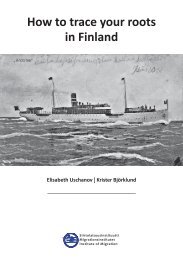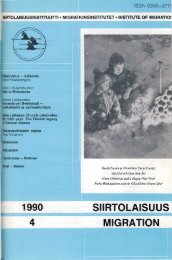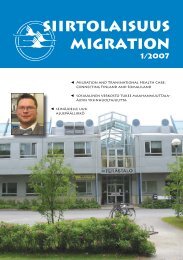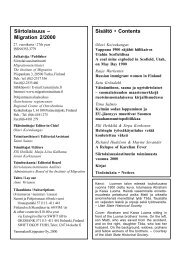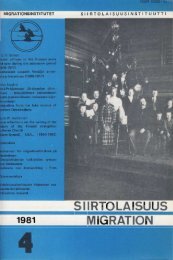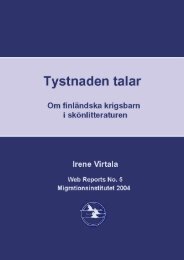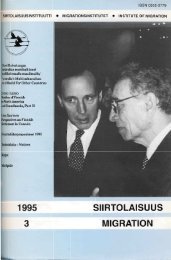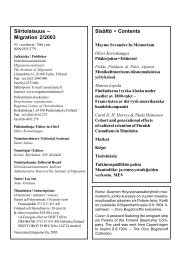1992 - 2 - Siirtolaisuusinstituutti
1992 - 2 - Siirtolaisuusinstituutti
1992 - 2 - Siirtolaisuusinstituutti
You also want an ePaper? Increase the reach of your titles
YUMPU automatically turns print PDFs into web optimized ePapers that Google loves.
l---*<br />
It was the earlier historical experiences of this nation which shaped the<br />
conditions and those individuals who in 1917 seized the opportunity for independence.<br />
The moment was righl the process by which this independence was<br />
achieved indicates that earlier the time would not have been ripe, while later<br />
circumstances would never have provided such a favorable opportunity again.<br />
Yet those earlier circumstances, which shaped the natiory also drove some of<br />
its people out - some east, some west, some still further away, and even some<br />
to the east via the west. As a consequence, today there are Finns scattered all over<br />
the globe, some of them living in communities now on the verge of extinction.<br />
The experiences and surroundings of each of these communities have been<br />
different, and often harsh; their environment has changed them, too, in many<br />
ways/ even extending to their language and way of life.<br />
One thing endures, however: the shared roots, the shared experiences, which<br />
even in changed circumstances continue to exert a constant influence. Often this<br />
remains unrecognized; yet at times, we also consciously ask ourselves the question:<br />
"Who am I?" - and thus encounter the uniting factor of our roots. Consequently,<br />
the 75th anniversary of Finnish independence this year is especially<br />
dedicated not only to the citizens of Finland, celebrating their sovereignty, but<br />
also to all those Finns outside our national borders who are searching for their<br />
roots.<br />
Our earlier experiences, from the period before we achieved independence,<br />
have also exerted a powerful influence on our political choices since independence.<br />
In the 1930s, when European prosperity was shaken by rival totalitarian<br />
threats, many countries - including all our neighbor states with the exception<br />
of Sweden - chose the path of quiet acquiescence. We chose differently. For this<br />
we paid a high price, but we won the prize of unbroken independence not only<br />
for our own people, but indirectly also for Sweden as well.<br />
Taught by these experiences/ our choices in the post-War period have also been<br />
distinctive: whereas Norway and Denmark, for instance, now chose a harder line,<br />
symbolized in their affiliation to NATO, Finland now chose the gentler path of<br />
peaceful coexistence.<br />
Our neighbors, the Baltic states,whose own quiet acquiescence failed to avert<br />
the sacrifice of their victims, are now in the throes of new, fundamental changes<br />
and facing a time of radical reappraisal. Once again, for all of these countries, it<br />
is a time for choices; and as Europe becomes increasingly integrated, the option<br />
of No Change, of standing outside the current of events, is no longer open.<br />
Whatever option we choose, we shall have to come to terms with the imposition<br />
of European perspectives on almost all that we do. Nevertheless, the circumstances<br />
have changed. This time, the question is not one of submission to superior<br />
force, but of affiliation to a team - even if in some people's minds some members<br />
of that team are too strong. That, however, is precisely where the difference lies.<br />
When there are many strong members, they are compelled to restrain their<br />
strength, and to recognize their mutual differences of interest.




